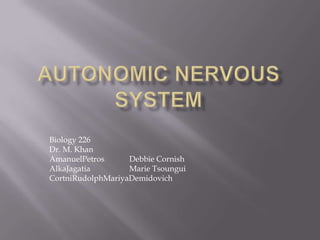
Ans presentation
- 1. Autonomic Nervous System Biology 226 Dr. M. Khan AmanuelPetros Debbie Cornish AlkaJagatia Marie Tsoungui CortniRudolphMariyaDemidovich
- 2. Introduction Autonomic Nervous System Auto (self) nom (govern) We are not in control of the functions that are performed by the ANS It is the involuntary nervous system
- 3. Organizational chart of the nervous system
- 5. Parasympathetic/Sympathetic The ANS acts through a balance of its two separate subdivisions. They serve many of the same target organs through dual innervation. They work antagonistically to one another to maintain homeostasis. Whatever one stimulates, the other inhibits.
- 6. Sympathetic “fight-or-flight” Acts in emergency situations that cause stress and require us to “fight” or “flight” Located to the sympathetic chain which connects skin, blood vessels, organs in the body The sympathetic chain is located in the spine and consists of ganglia
- 7. Parasympathetic Responsible for the control of involuntary body functions Known as the “rest and digest system” Works to counterbalance the sympathetic nervous system to maintain the body in homeostasis
- 8. Comparison
- 10. Constantly active at a basal level to maintain homeostasis
- 11. The hypothalamus is the main integration center of the ANS
- 12. Two kinds of neurons involved in the transmission of any signal through the sympathetic system
- 13. Preganglion
- 14. Postganglion
- 15. Preganglionic fibers are located in the spinal cord (T1-L2) known as the “Thoracolumbar Division”
- 17. Sacral Outflow Most of the large intestine and pelvic organs Distal half of large intestine Urinary bladder Ureters Reproductive organs
- 18. Thoracolumbar Preganglionic fibers come from cell bodies of preganglionic neurons in spinal cord (T1-L2) After leaving the cord via the ventral root, preganglionic fibers pass through a white ramuscommunicans to enter the sympathetic truck (chain) ganglia The sympathetic trunks flank each side of the vertebral column
- 20. Neurotrasmitters Substances released from neurons that influences the likelihood that an action potential in the presynaptic terminal will result in the postsynaptic cell Effects of autonomic activity lies in knowing which neurotransmitters are released by the autonomic fibers and what kind of receptors occur on the target cells
- 21. Axon terminals of autonomic neurons release two neurotransmitters Norepinephrine (adrenergic fibers) Acetylcholine (cholinergic fibers) Majority of sympathetic postganglionic fibers are adrenergic Cholinergic fibers include all preganglionic fibers of both division Postganglionic fibers of parasympathetic Few sympathetic postganglionic fibers
- 22. Receptor Type Norepinephrine affects visceral effectors by first binding to adrenergic receptors in their plasma Adrenergic receptor types Alpha ( ) Beta ()βα Subtypes of alpha and beta receptors include (B1, B2, B3, A1, A2)
- 23. ACh binds to cholinergic receptors Nicotinic Muscarinic Subtypes Nicotinic-1, Nicotinic-2 Muscarinic-1, Muscarinic-2, Muscarinic-3 All Ach receptors are either nicotinic or muscarinic
- 25. Autonomic Disorders Most reflect exaggerated or deficient control of smooth muscle activity Hypertension (high blood pressure) Results from an overactive sympathetic vasoconstrictor response Makes the heart work harder to pump blood to the body Contributes to arthrosclerosis (hardening of arteries) Factors that contribute to hypertension; smoking, weight, genetics, chronic kidney disease, thyroid disorders
- 27. Damage to SNS
- 28. Major sign is drooping of the upper eyelid
- 29. Due to loss of sympathetic innervation to the eye (superior tarsal muscle)
- 30. Raynauds Disease (Body limits blood flow to hands and feet)Exaggerated vasoconstriction response Provoked by exposure to cold or emotional stress In severe cases, blood circulation to fingers and toes diminish leading to skin ulcers or gangrene Vasodilators are used as treatment
- 31. Autonomic neuropathy Common complication of diabetes mellitus Nerve damage occurs due to high blood glucose Symptoms include dizziness and urinary discontinance Autonomic Dysreflexia (hyperreflexia) Dangerous complication of spinal cord injury Uncontrolled activation of autonomic neurons Spinal cord injuries at T6 or higher are at rish Trigger is painful stimulus to the skin or overfilling of visceral organs Elevated blood pressure can lead to stroke
- 32. Biofeedback The use of instrumentation to monitor and feedback to the patient Originally thought that the ANS could not be controlled voluntarily Voluntary cortical control of visceral activities is possible through biofeedback Physiological processes may be brought under voluntary control Visual imagery Diaphragmatic breathing (deep breathing to slow the stress response)
- 33. Instrumentation used to train the patient EMG (electromyography) & temperature trainer Tem. Training = hand warming through visual imagery Leads to to vasodilation in the blood vessels of the body EMG training = method of learning used to achieve deep muscle relaxation through feedback